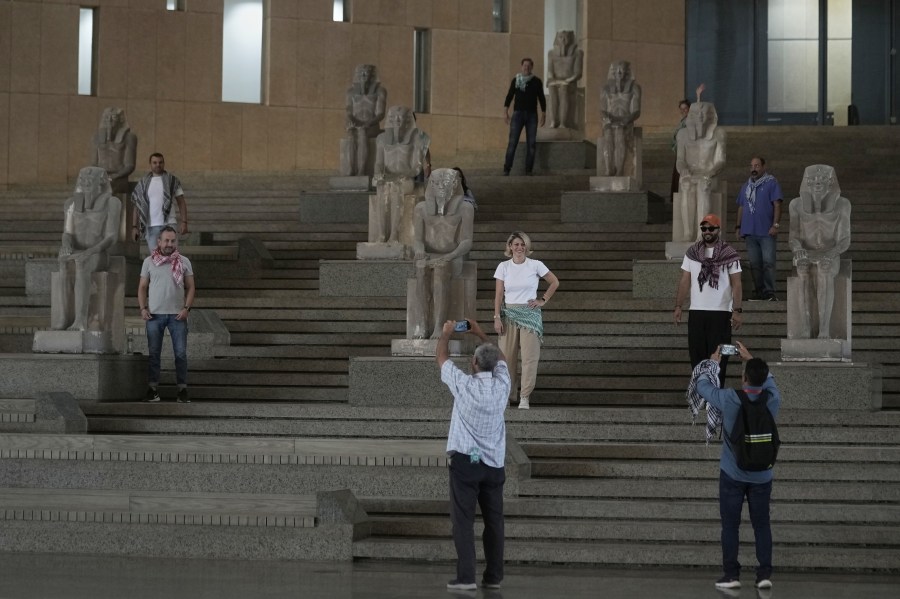
With pharaoh-fanfare, Egypt unveils a huge new museum dedicated to its ancient civilization
CAIRO (AP) — Egypt on Saturday was inaugurating the long-delayed Grand Egyptian Museum, the world’s largest museum dedicated to an ancient civilization — a megaproject also aimed at boosting the country’s tourism industry and troubled economy.
Two decades in the making, the museum located near the Giza Pyramids and Sphinx showcases over 50,000 artifacts detailing life in ancient Egypt. It will display the entire collection of treasures from the tomb of the famed King Tutankhamun for the first time since its discovery in 1922.
World leaders, including monarchs, heads of states and governments, were to attend the grand opening ceremony in the Egyptian capital, according to the president’s office, which touted the museum as “an exceptional event in the history of human culture and civilization.”
President Abdel-Fattah el-Sissi wrote on social media that the museum will bring “together the genius of ancient Egyptians and the creativity of modern Egyptians, enhancing the world culture and art with a new landmark that will attract all those who cherish civilization and knowledge.”
A ‘symphony of humanity’
The museum, known as GEM, is one of several megaprojects championed by el-Sissi since he took office in 2014, embarking on massive investments in infrastructure with the aim of reviving an economy weakened by decades of stagnation and battered by the unrest that followed the 2011 Arab Spring uprising.
The museum is expected to attract 5 million visitors annually, said Egyptian businessman Sir Mohamed Mansour, who is a member of GEM’s board of trustees. That would put it in the ranks of the most popular museums in the world. In 2024, by comparison, Paris’s Louvre brought in 8.7 million, the British Museum 6.5 million and the Metropolitan Museum of Art in New York 5.7 million.
“It’s going to have a huge impact” on the economy, Mansour told The Associated Press.
The government has heralded the grand opening with a burst of pharaoh-mania. On Friday night, hundreds of drones created a light show in the sky of King Tut’s mask and chariot and other of the museum’s most famous pieces. Media have been playing Egyptian pop songs with videos featuring dancing pharaonic statues.
A public holiday was declared Saturday, and security around Cairo was tightened. A stage was built in the museum courtyard where an orchestra and musicians would later perform what the Egyptian media described as a “global symphony of humanity.”
The museum, which has been partially open since last year, was closed for the past two weeks for final preparations.
Ramses the Great and King Tut
Construction on the $1 billion project was begun in 2005 under then-President Hosni Mubarak. It aimed to replace the Egyptian Museum, a more than century-old building in downtown Cairo that had become packed and disorganized, unable to deal with the sheer amount of ancient antiquities in Egypt.
But work on the museum was interrupted by turmoil surrounding the 2011 uprising that brought down Mubarak. Further delays ensued, and a planned grand opening over the summer had to be put off after the 12-day-long war between Israel and Iran erupted in June.
The museum boasts a towering, triangular glass façade imitating the nearby pyramids, with 24,000 square meters (258,000 square feet) of permanent exhibition space.
It opens to a granite colossus of Ramses the Great, one of ancient Egypt’s most powerful pharaohs who reigned for around 60 years, from 1279 B.C. to 1213 B.C., and is credited with expanding ancient Egypt’s reach as far as modern Syria to the east and modern Sudan to the south. The statue greets visitors once they step inside the museum’s angular atrium.
From the atrium, a grand six-story staircase lined with ancient statues leads up to the main galleries and a view of the pyramids. A bridge links the museum to the pyramids, allowing tourists to move between them either on foot or via electric vehicles, according to museum officials.
The museum’s 12 main galleries, which opened last year, exhibit antiquities spanning from prehistoric times to the Roman era, organized by era and by themes.
Two halls that will be opened for the first time with the grand opening are dedicated to the 5,000 artifacts from the collection of King Tutankhamun — a boy pharaoh who ruled from 1361-1352 B.C. The tomb was discovered by British archaeologist Howard Carter discovered King Tut’s tomb in 1922 in the southern city of Luxor. But the old Egyptian Museum didn’t have enough room to display the whole collection, parts of which were often on tour to museums abroad.
The collection includes the boy pharaoh’s three funeral beds and six chariots, his golden throne, his gold-covered sarcophagus and his burial mask, made of gold, quartzite, lapis lazuli and colored glass.
Zahi Hawass, Egypt’s most renowned archaeologist and former minister of antiquities, said the Tutankhamun collection is the museum’s masterpiece.
“Why this museum is so important, and everyone is waiting for the opening?” he told The Associated Press. “Because of Tutankhamun.”
Boost to tourism and economy
Officials hope the museum will draw more tourists who will stay for longer periods and provide the foreign currency needed to shore up Egypt’s battered economy.
The government has also revamped the area around the museum and the nearby pyramids and the Sphinx. New highways were built, and a metro station is being constructed nearby. An airport, Sphinx International Airport, has also opened west of Cairo — 40 minutes from the museum.
The tourism sector has suffered during years of political turmoil and violence following the 2011 Arab Spring uprising. In recent years, the sector has started to recover after the coronavirus pandemic and amid Russia’s war on Ukraine — both countries are major sources of tourists visiting Egypt.
A record number of about 15.7 million tourists visited Egypt in 2024, contributing about 8% of the country’s GDP, according to official figures. Tourism and Antiquities Minister Sherif Fathy has said that overall, Egypt expects about 18 million tourists this year, with authorities hoping for 30 million visitors annually by 2032.
This will translate into more jobs and pump foreign currency into the economy, said Walid el-Batouty, a tour guide.
“It will be boost the economy of Egypt tremendously not just the hotels and the museum itself,” he said. Whenever a tourist rides a cab or even just buys a bottle of water, “that is pumping money” into Egypt’s coffers, he added.
The museum will open to the public starting Nov. 4 — the anniversary of Carter’s discovery of Tutankhamun’s tomb, authorities said.
___
Associated Press journalist Ahmed Hatem in Cairo contributed to this report.

Comments are closed.